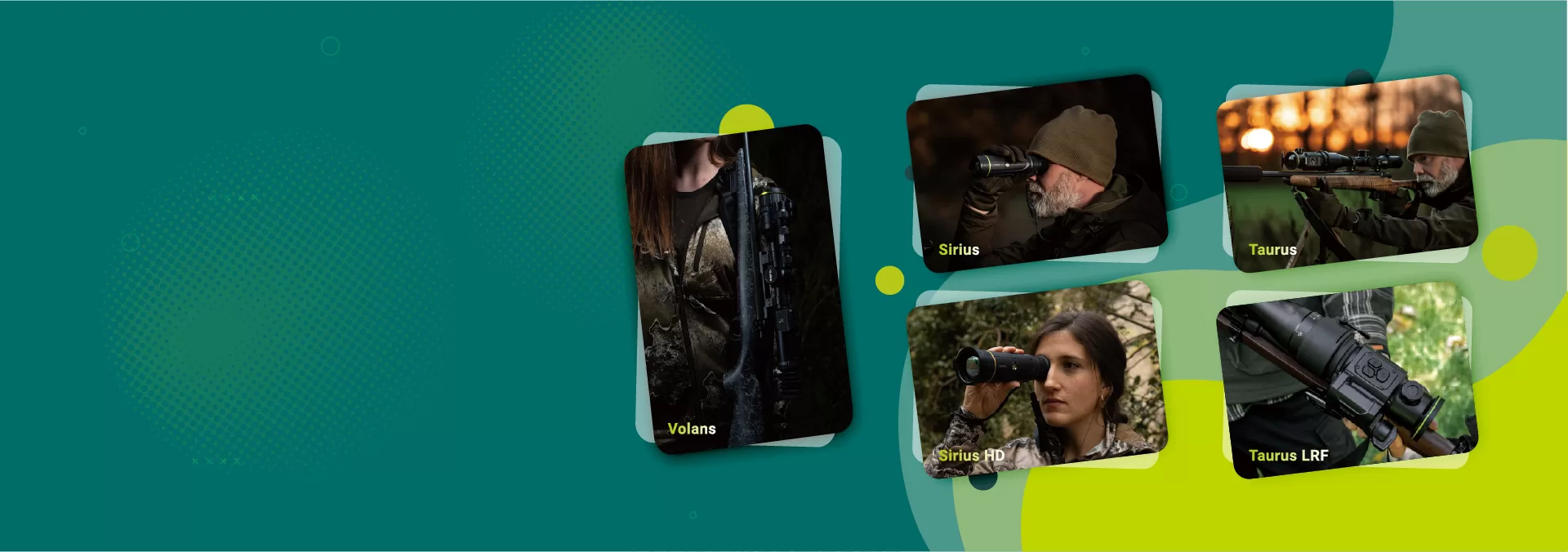Thermal imaging technology operates on fundamentally different principles than traditional optics, detecting heat radiation (infrared energy) rather than visible light. This operational difference creates both unique capabilities and specific weather-related considerations that European hunters must understand to maximize effectiveness in diverse environmental conditions. The core physics behind thermal imaging directly influence its performance across varying weather scenarios common throughout European hunting territories.
Thermal cameras detect infrared radiation in the 8-14 μm wavelength range—far beyond the visible spectrum (0.4-0.7 μm)—providing the distinct capability to “see” heat signatures regardless of ambient light conditions. This radiation emanates from all objects above absolute zero, with intensity proportional to temperature. The European Thermal Imaging Research Institute explains:
“Unlike visible light, which primarily reflects off surfaces, thermal infrared radiation represents direct emission from objects based on their temperature and emissivity properties. This fundamental difference enables detection through darkness and certain environmental conditions that block visible light but permit infrared transmission.”
Critical to understanding weather effects is the concept of thermal contrast—the temperature differential between targets and their surroundings. Higher contrast results in clearer thermal images, while reduced contrast diminishes detection capability. Weather conditions primarily affect thermal imaging by altering this critical contrast in several specific ways: changing ambient background temperatures, affecting target surface temperatures, or introducing atmospheric interference between the thermal device and target.
The Pixfra thermal imaging lineup features advanced sensor technology and specialized processing algorithms specifically designed to maintain performance across diverse weather conditions common throughout European hunting territories. The flagship Sirius Series incorporates high-sensitivity sensors (<18mK NETD) that detect minute temperature differentials even in challenging environmental conditions with naturally reduced thermal contrast.
Rain
Rain presents specific challenges for thermal imaging operations common throughout European hunting territories, particularly in regions including Northern France, Germany, and the United Kingdom where precipitation occurs frequently during primary hunting seasons. The impact of rain on thermal imaging performance occurs through several distinct mechanisms that European hunters must consider when operating in these conditions.
Direct thermal equalization represents the primary challenge, as raindrops striking objects tend to equalize surface temperatures between targets and surroundings. This effect reduces the critical thermal contrast necessary for clear target identification. Wild game surfaces, typically maintaining temperature differentials of 5-15°C above background in dry conditions, may show reduced differentials of only 2-4°C during moderate rainfall, significantly impacting detection ranges and image clarity.
Atmospheric attenuation creates the secondary challenge, as water droplets suspended in air between the thermal device and target absorb and scatter infrared radiation. The European Weather Imaging Research Center reports:
“Moderate rainfall (5mm/hr) typically reduces effective thermal imaging range by approximately 40-45% compared to clear conditions, with heavy rainfall (>10mm/hr) potentially reducing ranges by 60-70% in controlled testing environments.”
Despite these challenges, modern thermal imaging technology retains significant advantages over conventional optics in rainy conditions. While rain degrades thermal performance, it typically eliminates conventional optical visibility almost entirely, making degraded thermal capability still superior to alternative technologies. The Pixfra Mile 2 Series implements specialized contrast enhancement algorithms specifically designed to maximize performance during European rainfall conditions, automatically adjusting image processing parameters to extract maximum usable information from rain-affected thermal scenes.
The practical impact for European hunters operating in rain-prone regions requires adjustment of expectations and tactics rather than abandonment of thermal technology. Detection ranges will decrease substantially, necessitating closer approach distances and greater attention to movement discipline. The automatic rain optimization mode in Pixfra thermal devices activates automatically when rainfall patterns are detected, implementing specialized processing parameters that maximize performance under these challenging conditions.
Fog
Fog conditions create distinctive effects on thermal imaging performance that differ substantially from their catastrophic impact on conventional optics. For European hunters operating in fog-prone regions including coastal areas of France, low-lying regions of Germany, and valley systems throughout Alpine territories, understanding these effects proves essential for effective field application.
The primary advantage of thermal imaging in fog conditions stems from the longer wavelength of thermal infrared radiation (8-14 μm) compared to visible light (0.4-0.7 μm). This fundamental physical difference allows thermal radiation to penetrate fog more effectively than visible light. The European Optical Physics Institute explains:
“Typical valley fog with water droplet diameters of 1-5 μm creates minimal scattering effect on thermal infrared wavelengths (8-14 μm), while completely blocking visible light transmission, giving thermal imaging a significant advantage in these common European hunting conditions.”
However, this advantage varies significantly based on fog density and composition. Light to moderate fog typically permits thermal detection at 40-60% of clear-condition ranges, while extremely dense fog may reduce effectiveness to 15-30% of normal ranges. Despite this reduction, thermal imaging maintains substantial advantages over conventional optics, which become essentially non-functional in moderate to heavy fog conditions common throughout European hunting territories.
The Pixfra Sirius Series features specialized fog optimization modes that implement advanced signal processing algorithms specifically designed for European fog conditions. These processing enhancements automatically detect fog-characteristic signal patterns and apply appropriate contrast enhancement, enabling maximum performance in these challenging environments frequently encountered throughout primary European hunting regions.
For European hunters operating in fog-prone territories, thermal imaging often represents the only viable detection option during these conditions, particularly valuable for management activities including wild boar control in agricultural areas where operations must continue regardless of visibility conditions. While detection range expectations must be adjusted, the technology maintains fundamental effectiveness when conventional optics fail completely.
Temperature
Ambient temperature conditions significantly impact thermal imaging performance through several distinct mechanisms that European hunters must consider when operating across the diverse seasonal conditions encountered throughout European hunting territories. Both extreme cold and extreme heat create specific challenges through different physical mechanisms.
Cold weather operation presents several challenges despite common misconception that cold conditions automatically improve thermal imaging. The primary challenge stems from reduced thermal contrast between game animals and surroundings when background temperatures approach animal surface temperatures. The European Wildlife Thermal Research Group reports:
“Red deer surface temperature typically maintains 5-8°C differential above ambient in moderate conditions, but this differential can decrease to 2-3°C in extreme cold, reducing detection contrast and effective identification range by approximately 35-40%.”
This effect becomes particularly pronounced in snow-covered environments common throughout Northern and Central European hunting territories during winter seasons. Snow’s high emissivity creates uniform background temperatures that reduce contrast with partially snow-covered wildlife, potentially creating camouflage effect in thermal spectrum through reduced differential signatures.
The Pixfra thermal lineup counters these challenges through advanced thermal sensitivity, with the Sirius Series achieving <18mK NETD (Noise Equivalent Temperature Difference)—detecting temperature differences as small as 0.018°C. This exceptional sensitivity maintains detection capability even with the reduced thermal differentials encountered in extreme cold conditions common throughout Northern European hunting territories.
Hot weather operation creates different challenges, primarily through atmospheric thermal turbulence and potential sensor saturation in extreme conditions. Air temperature variations create thermal mirages similar to optical mirage effects, potentially distorting images at extended ranges. The European Hunting Technology Institute notes detection range reductions of 20-30% in extreme heat conditions (>35°C) primarily due to thermal turbulence effects rather than direct detection limitations.
Humidity
Humidity levels create subtle but significant effects on thermal imaging performance that can impact European hunting operations, particularly in high-humidity regions including coastal territories and during seasonal humidity peaks in Central European hunting grounds. These effects manifest through several specific mechanisms that European hunters should consider when operating in these diverse conditions.
Atmospheric attenuation increases with humidity as water vapor absorbs certain infrared wavelengths. This effect reduces signal strength over distance, with the impact proportional to both humidity levels and distance to target. The European Atmospheric Research Institute reports:
“Extremely high humidity conditions (>90% relative humidity) can reduce effective thermal detection ranges by approximately 25-30% compared to identical temperature conditions with low humidity (<30%), with effects becoming exponentially more pronounced beyond 500 meters.”
This attenuation effect creates particular challenges for long-range observation scenarios common in open European hunting territories including agricultural areas dedicated to wild boar management where extended detection ranges provide significant tactical advantages.
Condensation risk presents the secondary operational concern in high-humidity environments. Rapid temperature changes—common during dawn and dusk periods coinciding with prime European hunting hours—can create condensation on thermal equipment, potentially impacting performance or requiring maintenance interventions. The Pixfra thermal lineup incorporates specialized hydrophobic lens coatings specifically designed to minimize condensation effects during European dawn/dusk operations when humidity-related challenges typically peak.
Altered cooling patterns create the third consideration, as humidity affects how efficiently animals dissipate body heat through respiratory cooling. High humidity conditions reduce cooling efficiency, potentially enhancing thermal signatures of actively moving game. This effect sometimes creates detection advantages in high-humidity scenarios, partially offsetting the atmospheric attenuation effects previously described.
The practical implication for European hunters operating in diverse humidity conditions requires awareness of these effects rather than specific tactical adjustments. The automatic environmental calibration features in Pixfra thermal devices detect atmospheric conditions through integrated sensors and adjust processing parameters accordingly, helping maintain optimal performance across the diverse humidity conditions encountered throughout European hunting territories.
Wind
Wind conditions create surprisingly significant effects on thermal imaging effectiveness that many European hunters overlook when planning operations. These effects manifest through several specific mechanisms that impact detection capability across the diverse environmental conditions encountered throughout European hunting territories.
Surface cooling represents the primary wind effect, as moving air accelerates convective heat loss from exposed surfaces. This effect disproportionately impacts smaller exposed areas compared to larger thermal masses, potentially reducing contrast between game animals and surroundings. The European Wildlife Thermal Association reports:
“Strong wind conditions (>25 km/h) can reduce apparent surface temperature differentials between wildlife and surroundings by approximately 30-40% compared to identical temperature conditions without wind, particularly affecting smaller exposed body areas crucial for identification.”
This effect becomes particularly pronounced in open European hunting territories including agricultural areas and highland regions where wind conditions frequently intensify during primary hunting seasons. The cooling effect varies by species based on insulation properties, with thin-skinned species showing more pronounced effects than well-insulated species.
Vegetation movement creates the secondary challenge, as wind-disturbed vegetation generates dynamic thermal patterns that can mask wildlife movement or create false positive detections. This effect poses particular challenges in European hunting scenarios involving partial vegetation cover—common throughout managed forest territories in Germany, France, and Eastern European hunting regions.
The Pixfra thermal lineup counteracts these effects through advanced motion-based detection algorithms specifically calibrated for European hunting conditions. The Sirius Series implements sophisticated digital signal processing that distinguishes between characteristic wildlife movement patterns and wind-induced vegetation movement, reducing false detections while maintaining target acquisition capability in challenging windy conditions.
For European hunters operating in wind-prone territories, tactical adjustments include increased focus on wind-sheltered observation areas where both wildlife and thermal equipment experience reduced wind effects. Additionally, the advanced environmental modes in Pixfra thermal devices automatically detect wind-characteristic thermal patterns and adjust processing parameters accordingly, helping maintain optimal performance regardless of wind conditions.
Conclusion
Weather conditions significantly impact thermal imaging performance through diverse mechanisms that European hunters must understand to maximize effectiveness across the variable environmental conditions encountered throughout European hunting territories. Rather than rendering thermal technology ineffective, adverse weather conditions typically create relative advantages compared to conventional optics while requiring specific adaptations to maximize performance.
Rain conditions reduce thermal contrast and create atmospheric attenuation, typically limiting detection ranges by 40-70% depending on intensity. Despite this reduction, thermal imaging maintains substantial advantages over conventional optics rendered essentially non-functional in rainy conditions. Fog presents similar relative advantages, with thermal wavelengths penetrating fog particles more effectively than visible light despite experiencing some attenuation at extreme densities.
Temperature extremes create distinct challenges through different mechanisms. Cold conditions reduce natural thermal contrast between game and surroundings, while hot conditions generate atmospheric thermal turbulence. Humidity levels create subtle but significant effects through atmospheric attenuation and altered animal cooling patterns. Wind conditions accelerate convective cooling and create detection challenges through vegetation movement.
Modern thermal imaging systems including the Pixfra product lineup incorporate sophisticated technologies specifically designed to counteract these weather-related challenges. Advanced sensor sensitivity, specialized processing algorithms, and automatic environmental calibration enable continued performance across diverse conditions. The Pixfra Sirius Series with industry-leading <18mK sensitivity and specialized environmental processing modes maintains effectiveness throughout the challenging and diverse weather conditions encountered across European hunting territories.
For European hunters and wildlife managers operating across diverse environmental conditions, understanding these weather effects enables realistic performance expectations and appropriate tactical adjustments rather than abandonment of thermal technology during adverse conditions. While weather inevitably impacts thermal performance, proper equipment selection and application knowledge ensures continued effectiveness regardless of environmental challenges.
Contact Pixfra
If you’re interested in exploring how Pixfra’s thermal imaging solutions perform across diverse European weather conditions, our technical specialists are available to provide detailed information and personalized recommendations based on your specific regional requirements. From the versatile Mile 2 Series to the premium Sirius Series with advanced environmental optimization modes, Pixfra offers thermal solutions engineered specifically for the challenging weather conditions encountered throughout European hunting territories.
Contact our European market specialists today at info@pixfra.com or visit pixfra.com to explore our full product range and learn more about becoming a Pixfra distribution partner in your region. Our team can provide territory-specific guidance on thermal performance across local weather conditions, technical specifications, and comprehensive support for your thermal imaging business.




